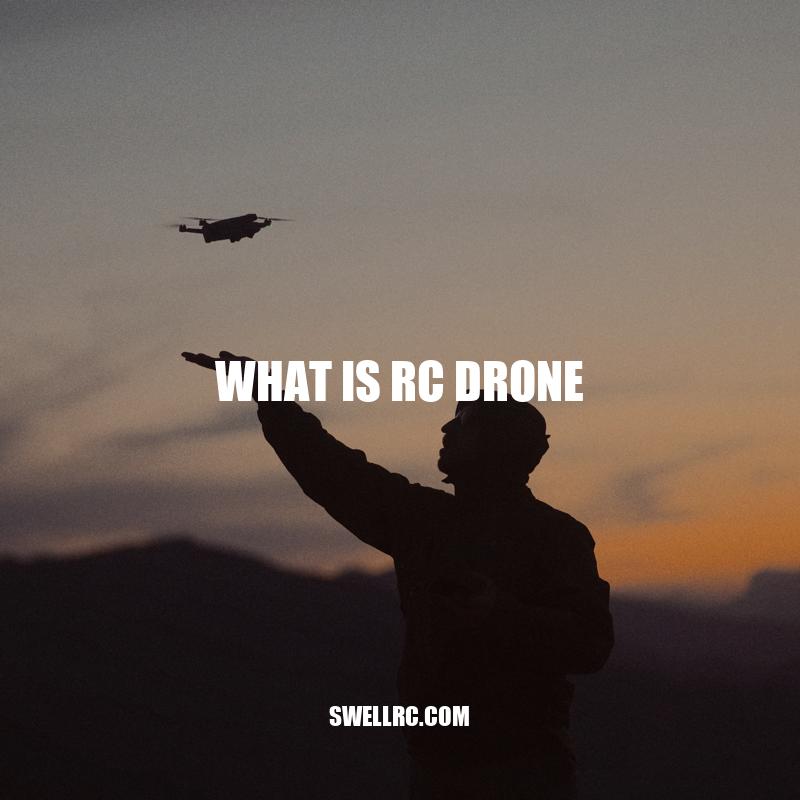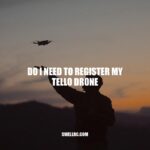Introduction to RC Drones: Types, Components, and Regulations
In recent years, RC drones have taken the world by storm. Their increased popularity is due to their affordability, versatility, and accessibility. RC stands for radio-controlled, and it implies that these drones are operated remotely by a person using a controller. The earliest form of RC drones was developed in the 1930s and was used mainly in radio-controlled aircraft competitions. Since then, technology has advanced, and these drones have been adopted for various applications such as aerial photography, surveillance, search and rescue, and many more. RC drones come in different sizes and are equipped with unique features, making them ideal for specific purposes. Some RC drones come with high-quality cameras, while others are optimized for speed and agility, ideal for racing competitions. Professional drones are designed with advanced features like obstacle avoidance sensors, long battery life, and GPS, making them perfect for commercial use. With the growing demand for this technology, drone companies have been able to design custom-made drones to fit the unique needs of individual clients. With so many available options, the possibilities of what you can do with RC drones are infinite. From filmmaking to package delivery, the uses of RC drones will only continue to evolve, and the future of this technology is limitless.
How RC Drones Work
RC drones are powered by a combination of hardware and software, working together to deliver a seamless flying experience. Below are the components of an RC drone and how they contribute to the drone’s functionality:
- The Body: Usually made from lightweight materials like plastic, carbon fiber, or aluminum, the body houses all the components and protects the inner workings of the drone.
- The Controller: A handheld device that sends signals to the drone’s onboard computer to control its movement.
- The Battery: Provides power to the drone for its operations in the air. Battery life ranges between 5-30 minutes, depending on the drone and the type of activity it is used for.
- The Propellers: Spinning blades that help the drone lift off the ground and maintain altitude.
- The Camera: For some drones, especially those used for aerial photography and videography, the camera is an essential part of the system. Cameras vary in quality, lenses, and resolution, depending on the drone’s purpose.
- The Sensors: Usually, gyroscopes, accelerometers, and barometers help the drone maintain its position and orientation while in flight. Some drones are also equipped with GPS, which provides more precise location tracking.
- The Software: The onboard computer, operating system, and software that runs the drone’s programs, encoding the user’s actions to mechanical movements.
For more information about specific RC drone models and features, check out websites like DJI, Holy Stone, and Hubson. They have comprehensive guides and instructional videos on how to operate different drones models.
How do RC drones work?
RC (remote-controlled) drones, also known as quadcopters or UAVs (unmanned aerial vehicles), are becoming popular for both recreational and professional purposes. Here’s a brief overview of how they work:
- RC drones are controlled by a transmitter, which you hold in your hand.
- Transmitters send signals to the drone’s receiver, telling it what to do.
- The receiver then sends these signals to the drone’s flight controller, which interprets them and adjusts the drone’s speed, direction, and altitude accordingly.
- Most drones have four rotors, or blades, which spin in opposite directions to provide lift and stability. By adjusting the speed of these rotors, the drone can move up, down, left, or right.
- In addition to the rotors, most drones also have sensors (such as gyroscopes and accelerometers) that help keep them stable and level.
- The drone’s camera (if it has one) is often mounted on a gimbal, which keeps it steady and level even as the drone moves.
If you’re interested in learning more about RC drones, there are many websites and products available to help you get started. Some popular options include DJI drones, which are known for their reliability and advanced features, and the websites dronefly.com and dronepilotgroundschool.com, which offer courses and resources for drone enthusiasts.
Types of RC Drones
RC drones come in various sizes and types, built for specific purposes. Below are four categories of RC drones and their unique features:
- Toy Drones: Small, lightweight, and easy to fly drones, most suitable for beginners.
- Racing Drones: Built for speed, agility, and maneuverability, with a streamlined and aerodynamic design.
- Camera Drones: Equipped with high-quality cameras and gimbals, which stabilize the image capture.
- Professional Drones: Drones with advanced technology, customized designs, and high-quality hardware and software.
Some interesting facts about RC drones include:
- Some drones can fly as high as 3,000 meters in the air.
- The world’s fastest drone flew at a speed of 296.37 km/h in a drone racing competition.
- Disney has created more than 1,000 light-up drones for a spectacular light show over the skies of California.
For the latest RC drone models, accessories, and expert reviews, check out websites like Drone Rush, Drone Life, and Quadcopter Fanatics.
What are the Categorisation of drones?
Drones, also known as unmanned aerial vehicles (UAVs), are categorised as per their size, weight, capabilities and usage. The categorisation of drones is as follows:
- Nano Drones
- Mini Drones
- Small Drones
- Medium Drones
- Large Drones
Nano drones are the smallest drones, weighing less than 2 pounds and ideal for indoor and close-proximity use. Mini drones are slightly larger, often used for leisure purposes, weighing up to 55 pounds. Small drones are the most common and widely used, weighing up to 330 pounds and often adopted for aerial photography, mapping and surveying. Medium drones are employed for commercial, research and military purposes, supporting heavy payloads and special mission requirements, weighing up to 1,320 pounds. Large drones can carry even larger payloads (up to 22,000 pounds) and used for military, surveillance and cargo transport purposes.
If you want to learn about drones or buy a drone, do check out websites like DJI or Amazon for their wide range of drone products.
Regulations and Ethics
Operating an RC drone comes with responsibility, and it’s essential to understand and follow regulations and ethical considerations. Here are some essential things to keep in mind:
Regulations
- FAA regulations require drone pilots to register their drones before flying them outdoors.
- There are airspace and height restrictions that drone pilots must follow.
- Drone pilots must always ensure the safety of other people, property, and aircraft while flying.
Ethics
- Respect other people’s privacy while operating your drone, and do not invade their personal space.
- Do not use your drone to harass or harm animals or wildlife.
- Do not fly your drone in areas close to emergency services, like hospitals and other medical facilities.
Several websites provide valuable information on drone regulations and safety practices. The FAA website provides details on drone registration and safety guidelines. Additionally, the Academy of Model Aeronautics provides safety guidelines and resources for its members. Dronepilot Ground School teaches drone pilots how to pilot their drones safety and legally.
How do I unregister a drone from the FAA?
To unregister a drone from the Federal Aviation Administration (FAA), follow these steps:
- Visit the FAA’s DroneZone website at https://faadronezone.faa.gov/#/.
- Login to your account or create a new one by clicking on “Register/Sign In.”
- Once you are logged in, click on “My Aircraft.”
- Select the drone you want to unregister from the list.
- Click on “Request to Delete.”
- Confirm the deletion request.
- The FAA will process your request and send you a confirmation email once the drone has been removed from your account.
Note that if you sell your drone, the new owner is required to register the drone under their own name and obtain a new registration number.
Conclusion
RC drones have revolutionized many industries and provided hobbyists with a fun and engaging activity. However, operating an RC drone comes with responsibility, and it’s essential to understand and follow regulations and ethical considerations. Additionally, there are different types of drones available in the market that cater to specific applications, and understanding their features can help you choose the right drone for your needs. By incorporating drones into your work or leisure time, you can unlock new possibilities and enhance your creativity.
From aerial photography to surveying and search-and-rescue missions, the applications for drones are only limited by our imagination. By embracing the convenience and excitement that RC drones offer, we can stay at the forefront of this rapidly-evolving technology. It’s crucial to educate ourselves, practice caution, and operate our drones safely and ethically to ensure that we help to shape and create a better future.



